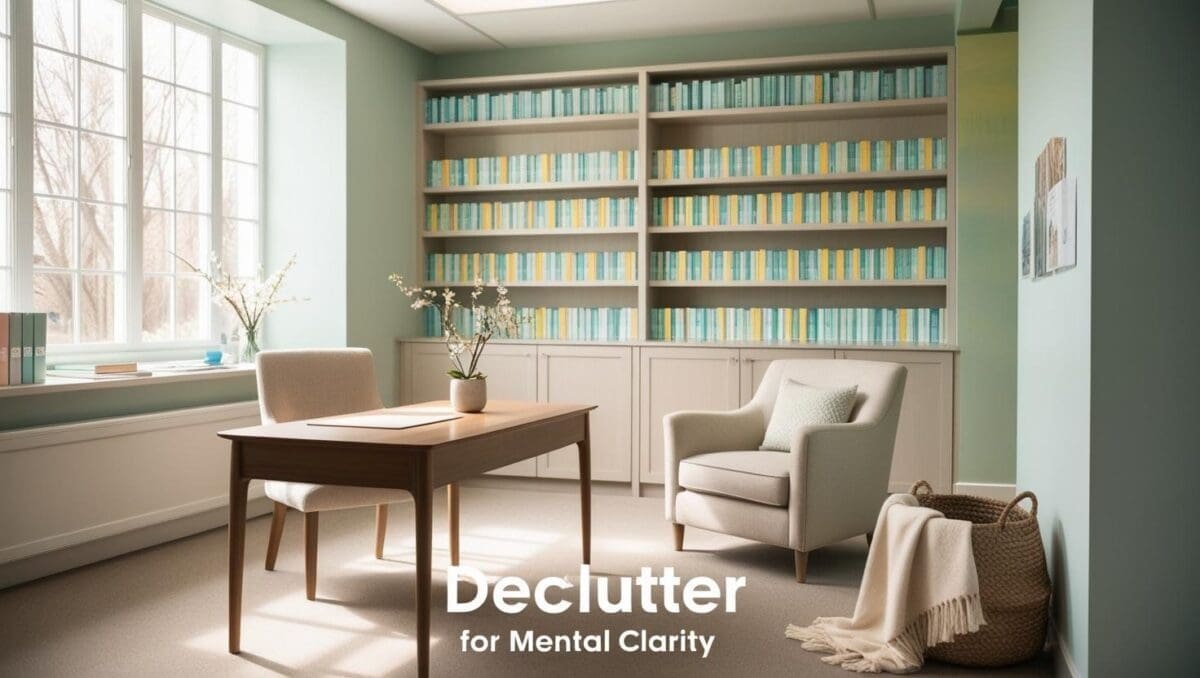In today’s design world, the power of a well‐crafted accent wall is undeniable—especially when it comes to creating therapy offices that not only serve as functional workspaces but also as sanctuaries of calm, introspection, and healing. A dark aesthetic accent wall can be the transformative element that elevates your therapy office from merely “a room” into a captivating environment that nurtures mental wellness and creativity.
This guide delves into 12 distinct approaches to designing dark accent walls for therapy offices. Whether you’re drawn to the timeless allure of deep charcoal paint or the modern sophistication of sleek, matte finishes, each section of this article offers practical design advice, expert insights, and meticulously detailed text prompts for creating imagery that reflects the mood, texture, and ambiance of each concept. Prepare to explore everything from hand-painted murals to industrial-inspired exposed brick—each idea is designed to evoke calm while sparking creative inspiration.
Throughout this article, you’ll find sections that detail:
- The benefits of dark accent walls in therapeutic spaces
- Step-by-step design suggestions and material recommendations
- Detailed image prompts to help you visualize and create Pinterest-worthy mood boards
So, whether you’re a therapist looking to revamp your office or a design enthusiast with a passion for dark aesthetics, this guide is your ultimate resource. Let’s journey through these 12 captivating ideas and discover how you can transform your therapy office into a space that inspires serenity, introspection, and innovation.
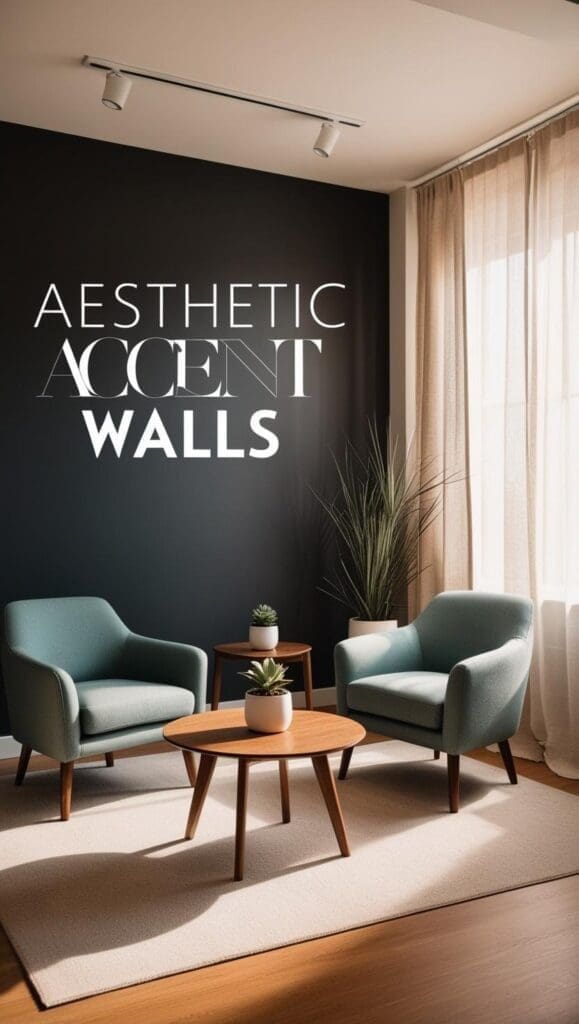
1. Midnight Elegance: Using Deep Charcoal Paint for a Serene Accent Wall
Overview
The first approach to creating a dark aesthetic accent wall for your therapy office is to embrace the classic sophistication of deep charcoal paint. Deep charcoal is a versatile, nearly neutral hue that can transform any space by providing a rich, dramatic backdrop. In therapy offices, this color works wonders—it evokes calm, offers a modern edge, and pairs seamlessly with both contemporary and traditional furnishings.
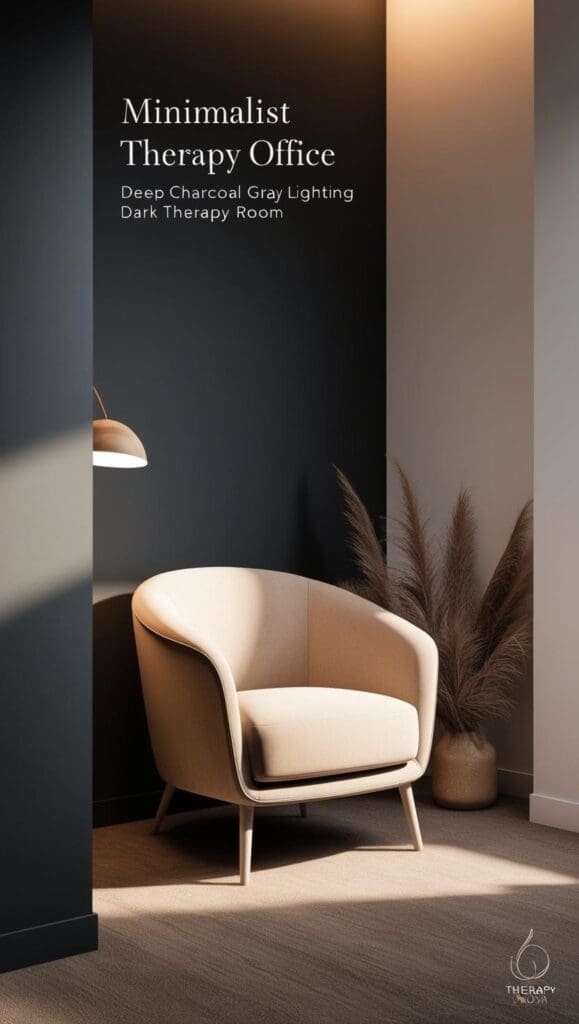
Why Deep Charcoal?
Deep charcoal is more than just a dark shade; it’s an experience. The psychological impact of a dark, cool tone can be soothing, offering a sense of balance and introspection. For therapy offices, where the environment is integral to a client’s comfort and openness, deep charcoal sets the perfect mood without feeling oppressive.
Selecting the Right Paint
When choosing a deep charcoal paint, consider the following:
- Finish: A matte or eggshell finish is ideal for a therapy office accent wall. These finishes reduce glare and create a smooth, velvety surface that absorbs light softly.
- Quality: High-quality, low-VOC paints are recommended for spaces where people spend extended periods. These paints ensure a healthier environment, a crucial factor in any therapeutic setting.
- Application: Use multiple coats to achieve a uniform, saturated finish. Consider hiring a professional if you’re aiming for a flawless, gallery-quality result.
Design Tips
- Contrast: Pair the deep charcoal accent wall with lighter furnishings and natural wood tones to create a balanced contrast. This not only enhances the wall’s dramatic appeal but also ensures that the space remains welcoming and not overly somber.
- Focal Point: Use the accent wall as the main focal point of the room. Arrange your seating and work areas so that the wall is prominently featured, drawing the eye and anchoring the room’s design.
- Lighting: Soft, ambient lighting is key. Consider installing wall sconces or recessed lighting to highlight the texture and depth of the charcoal finish.
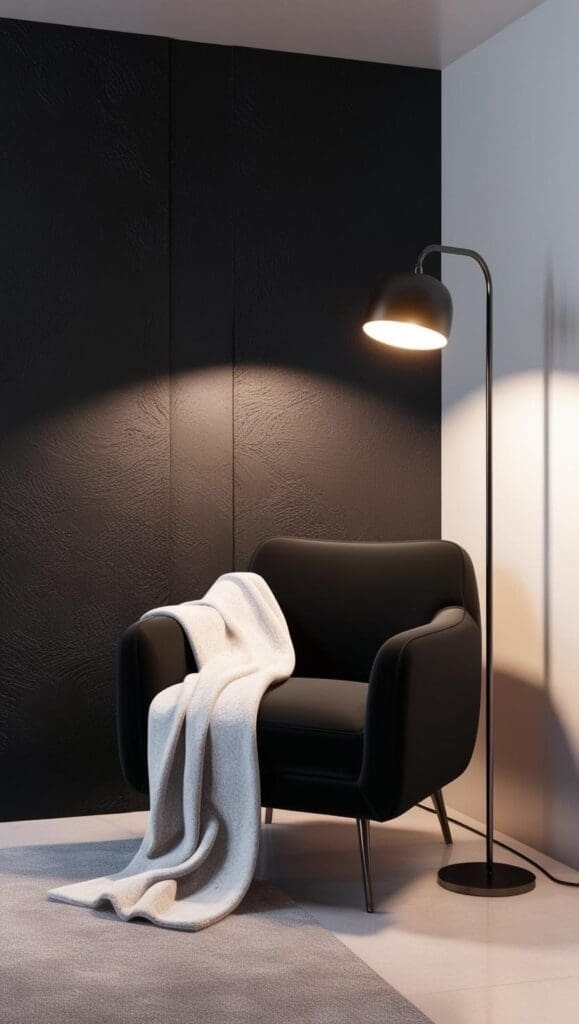
Practical Considerations
- Maintenance: Deep charcoal paint can show dust and fingerprints, so regular cleaning is necessary. Opt for a washable finish if your therapy office sees frequent use.
- Complementary Decor: Decorate around the accent wall with art pieces, shelves, or even a statement mirror to enhance its impact. Use decor elements that introduce subtle hints of color, ensuring the space feels lively yet introspective.
Detailed Text Prompt for an Image
Imagine a spacious therapy office where a single wall is transformed by the deep, velvety hue of charcoal paint. The wall is smooth, with a matte finish that softly diffuses the available light. In front of the wall, a minimalist seating area with plush, light-colored sofas and a glass coffee table creates a stark yet harmonious contrast. On one side, a slender, modern floor lamp casts gentle, ambient light that accentuates the wall’s depth and texture. The overall atmosphere is one of quiet elegance and sophisticated calm—a perfect retreat for thoughtful conversations and reflective therapy sessions.
2. Mystic Murals: Incorporating Hand-Painted or Stenciled Art on Dark Walls
Overview
For those seeking to infuse a dose of personality and artistry into a therapy office, consider transforming your dark accent wall into a canvas for mystical murals. Hand-painted or stenciled art can introduce a narrative element, offering both aesthetic appeal and an opportunity for therapeutic storytelling. Whether it’s abstract forms, nature-inspired motifs, or symbolic representations of transformation, a mural on a dark wall becomes a conversation starter that enriches the space.
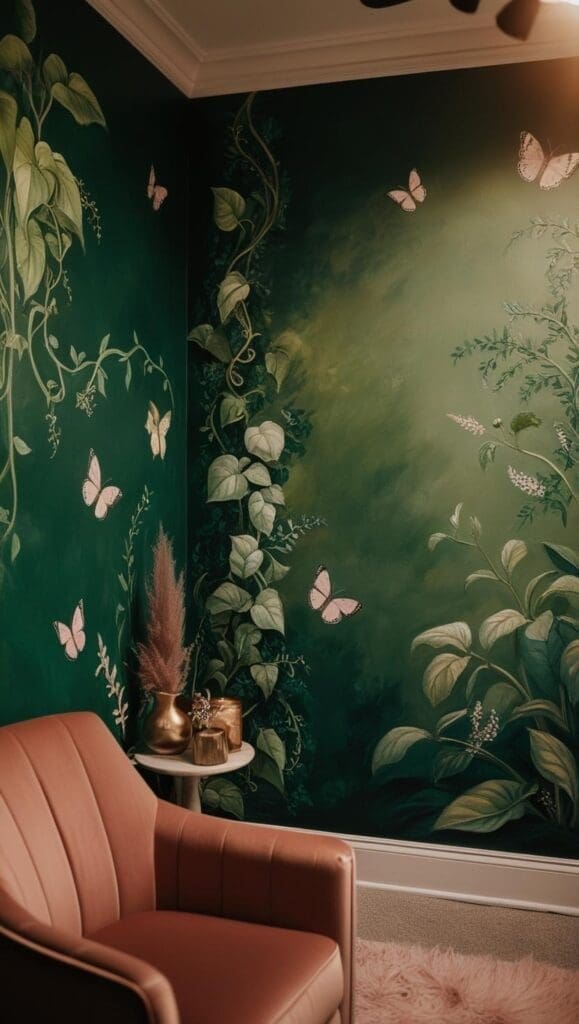
The Allure of Murals
Murals are not just decorative—they can be therapeutic. The process of creating or even choosing a mural invites reflection and mindfulness. In therapy offices, where the environment itself plays a role in healing, murals can help evoke emotions, stimulate conversation, and provide a sense of connectedness to larger narratives of growth and transformation.
Choosing the Right Design
- Theme: Select a mural theme that resonates with the ethos of your practice. Themes such as nature, cosmic patterns, or abstract forms work well with dark aesthetics.
- Color Palette: Even on a dark background, use accent colors that pop without clashing. Metallic hues like gold or silver, subtle blues, or even deep greens can create a harmonious yet dynamic composition.
- Technique: Consider techniques such as airbrushing, stenciling, or freehand painting. Each method offers a different texture and visual impact. Stenciling, for example, can introduce repeating patterns and symmetry, while freehand painting offers a more organic, fluid design.
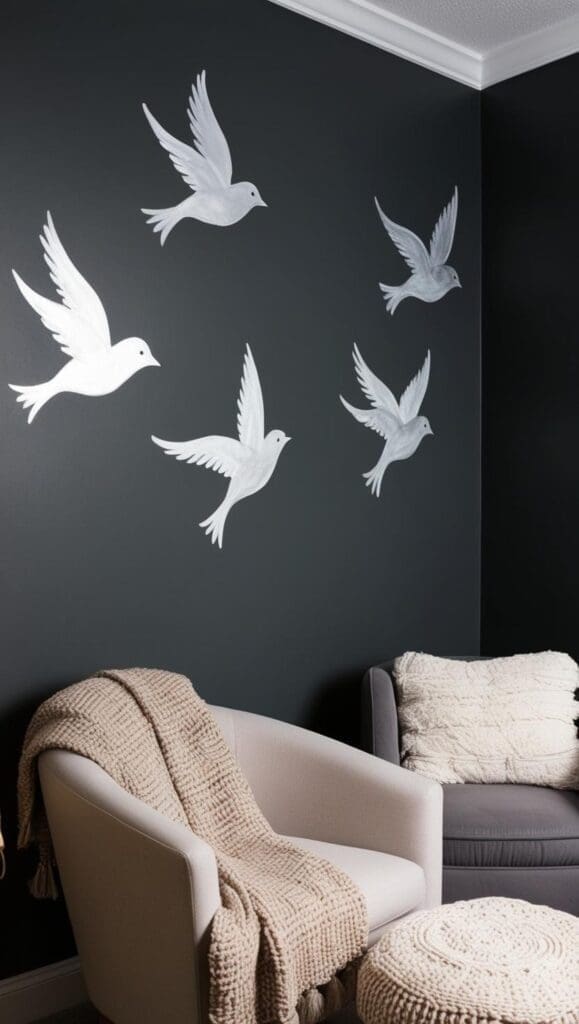
Execution and Installation
- Professional vs. DIY: Hiring a professional muralist can ensure a high-quality finish, especially if the design is intricate. However, for a more personal touch, you might opt to create the mural yourself or involve your clients in the creative process.
- Preparation: Proper surface preparation is critical. Ensure the wall is clean, smooth, and primed for painting. If necessary, apply a base coat that will help the mural’s colors stand out.
- Layering: Work in layers to build depth in the mural. Start with a background wash that complements the dark base, then layer in the design details gradually.
Enhancing the Mural with Lighting
- Spotlights: Use adjustable spotlights to highlight the mural’s key features. Focus on areas with intricate details to bring out the texture and depth.
- Ambient Lighting: Soft, diffused lighting around the mural can create an enchanting, almost ethereal effect, further enhancing the mood of the therapy space.
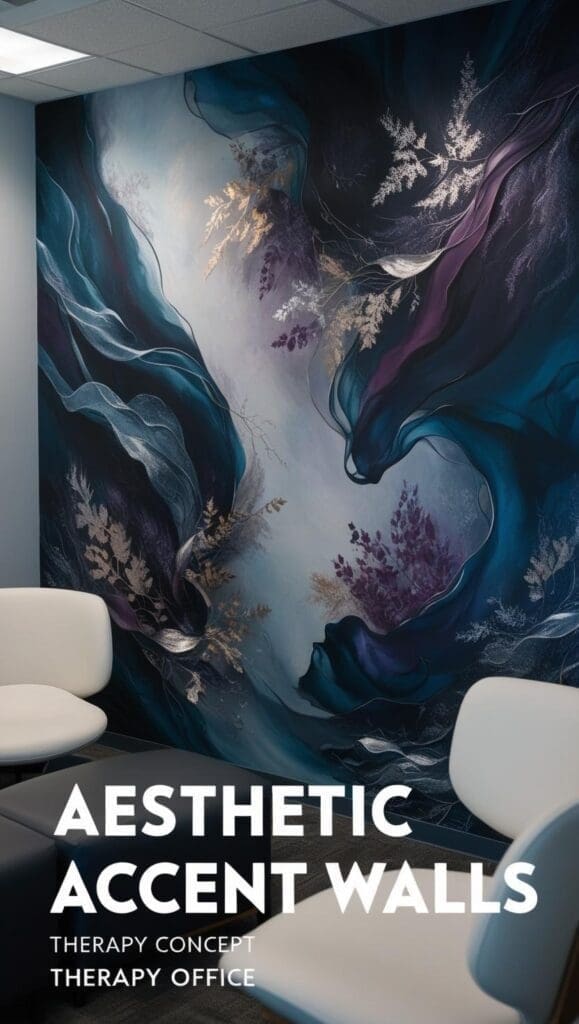
3. Luxurious Textures: Combining Dark Accent Walls with Tactile Wall Coverings
Overview
Texture is an often-underestimated element in interior design. When working with dark accent walls, adding tactile wall coverings can elevate the overall experience of the space. In therapy offices, where sensory input can play a crucial role in relaxation and mindfulness, incorporating textured materials not only enhances visual appeal but also invites touch and interaction. Think of fabrics, embossed wallpapers, and even natural materials like stone or wood veneers.
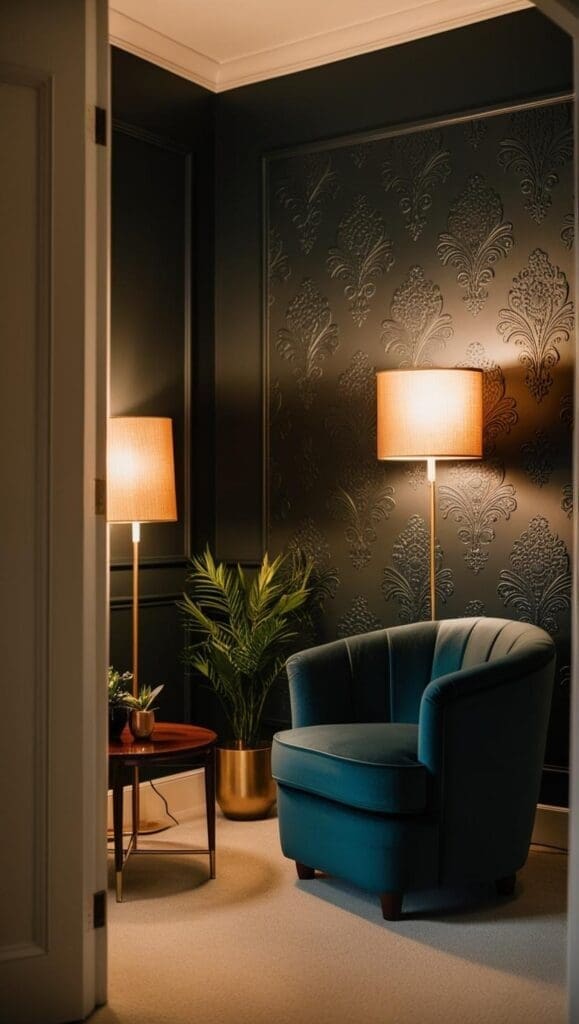
The Role of Texture in Design
Texture adds depth and complexity to a room. In a therapy office, a dark accent wall with a rich texture can stimulate the senses in a subtle, comforting way. It can soften the starkness of a single dark color by introducing layers of visual and tactile interest, making the space feel more dynamic and engaging.
Material Choices
- Embossed Wallpapers: Choose wallpapers with raised patterns in dark hues. Patterns such as damask, geometric shapes, or even nature-inspired motifs can add an intricate detail that enhances the wall’s character.
- Fabric Panels: Consider fabric wall panels in luxurious materials like velvet or suede. These panels not only add warmth but also offer a tactile element that clients might find soothing.
- Stone and Brick Veneers: For a more rugged yet refined look, stone or brick veneers in dark tones can create a striking textural contrast. These materials lend an industrial chic vibe while maintaining a sense of natural beauty.
- Wood Veneers: Dark wood veneers, with their natural grain and texture, can provide both elegance and warmth. They work especially well in offices that blend modern minimalism with classic elements.
Installation and Maintenance
- Preparation: Ensure the wall surface is properly prepared to support heavier materials like fabric panels or veneers. Reinforce the wall if necessary.
- Maintenance: While textured surfaces can accumulate dust, choose materials that are easy to clean. Removable and washable panels can be a practical solution.
- Layering: Combine different textures to create a multi-layered effect. For example, pair an embossed wallpaper with a fabric panel border to draw attention to specific areas of the wall.
Enhancing with Lighting
- Directional Lighting: Use directional lighting to cast shadows and emphasize the raised patterns or fabric folds. This technique can bring out the subtleties of the texture.
- Soft Ambient Light: Complement the directional lighting with soft ambient light that ensures the textures are visible without harsh glare, maintaining the room’s calming atmosphere.
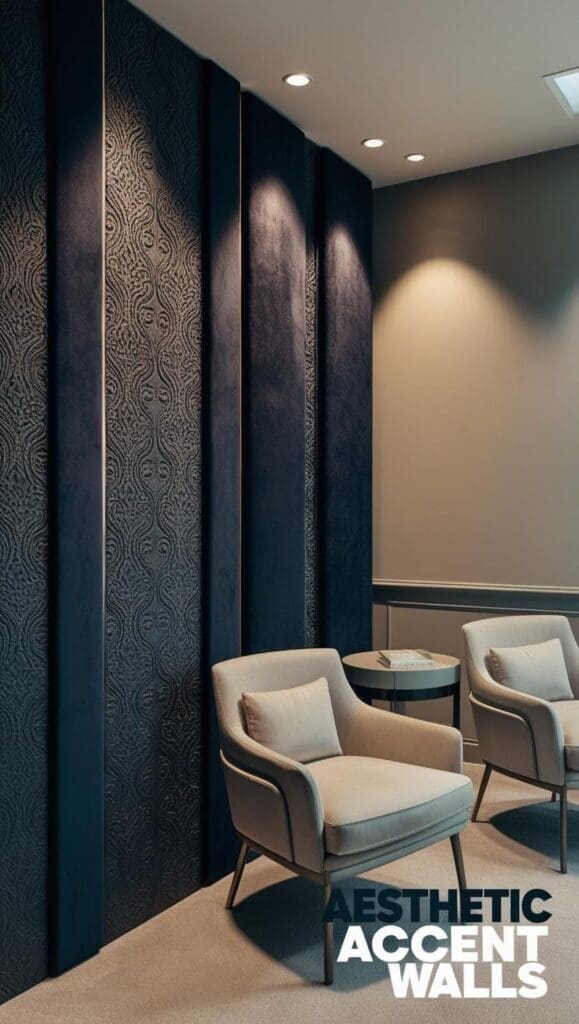
4. Industrial Noir: Exposed Brick and Concrete with a Dark Twist
Overview
Industrial design elements have surged in popularity, and when combined with a dark aesthetic, they can create an edgy, sophisticated atmosphere. Exposed brick and concrete, traditionally associated with urban lofts, are reimagined in this approach by treating them with dark finishes or incorporating them as accent pieces on a wall. For therapy offices, this style offers a perfect balance between raw, unfiltered authenticity and a refined, modern look.
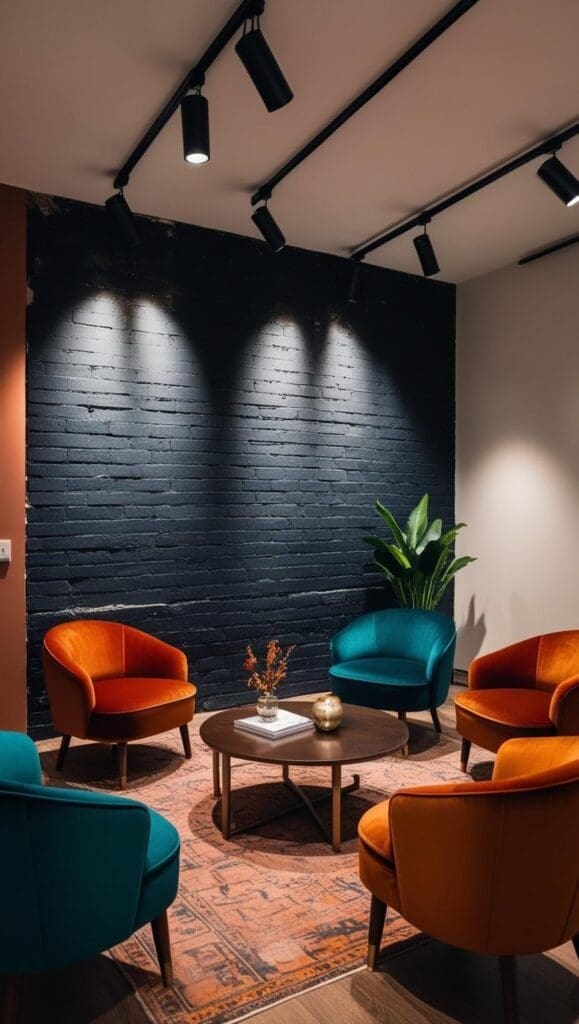
The Allure of Industrial Materials
Exposed brick and concrete bring a sense of authenticity and texture to any space. When finished in darker tones or paired with contrasting elements, they can evoke feelings of stability and grounding—essential qualities in a therapy setting. The industrial aesthetic, with its nod to urban life, adds an unexpected twist to spaces typically associated with calm and introspection.
Design Strategies
- Dark Stains and Finishes:
Use dark stains on brick surfaces to enhance their natural texture while aligning with the overall dark aesthetic. For concrete, consider a dark, matte finish that softens the raw material without losing its industrial edge. - Contrast and Balance:
Balance the industrial materials with softer elements. For example, pair a dark, exposed brick accent wall with warm lighting, plush seating, and natural wood accents to avoid a cold, harsh environment. - Mixed Materials:
Incorporate metal accents or glass shelving alongside the brick or concrete wall to add variety and modern sophistication. This mix of raw and refined elements creates a layered, complex design.
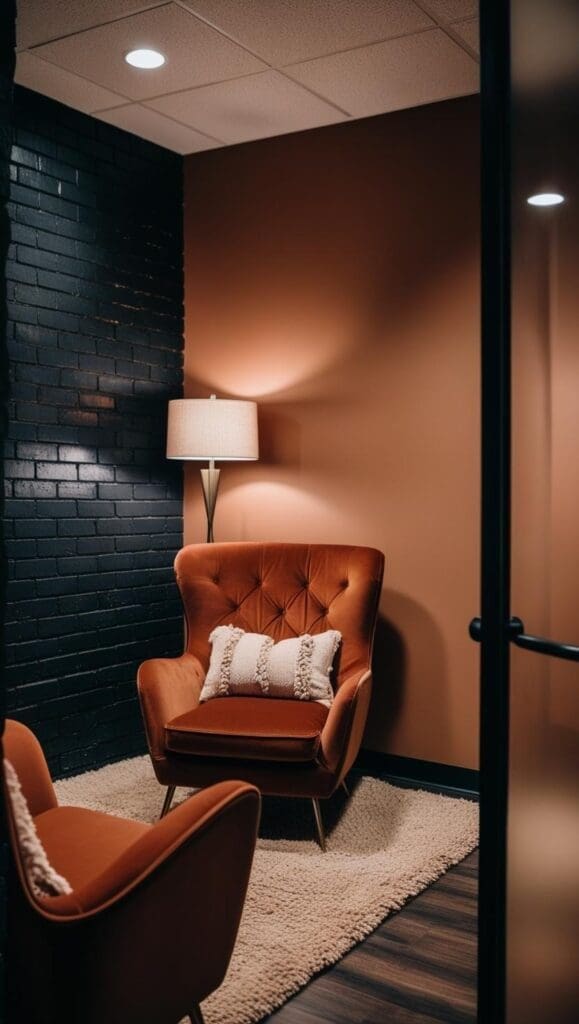
Installation and Considerations
- Structural Integrity:
Ensure that any exposed brick or concrete is properly treated and sealed to protect against dust and wear. This is particularly important in therapy offices, where the environment must be both beautiful and functional. - Lighting:
Use industrial-style fixtures, such as Edison bulbs or metal pendant lights, to further emphasize the raw, edgy appeal of the accent wall. The interplay between light and shadow on a textured surface enhances the dramatic effect.
5. Gothic Glam: Dark Wood Paneling for a Rich, Warm Ambience
Overview
Gothic glam marries the dramatic flair of Gothic design with modern sophistication. Dark wood paneling is at the heart of this aesthetic, offering a rich, textured backdrop that exudes warmth and elegance. For therapy offices, this style can create an environment that feels both timeless and intimate—a space where clients feel enveloped by a sense of history and comfort.
The Magic of Dark Wood
Dark wood, with its natural grain and intricate texture, has long been associated with luxury and depth. When used as an accent wall in a therapy office, it provides a tactile experience that is both visually stunning and emotionally grounding. The natural variations in the wood add character, while the deep tones create a cocoon-like atmosphere that can help clients feel safe and understood.
Design and Installation Tips
- Paneling Options:
Choose between traditional tongue-and-groove paneling, shiplap, or even reclaimed wood for a more rustic look. Each option offers a different texture and visual appeal, so consider the overall style of your therapy office. - Finish and Treatment:
Apply a dark stain or varnish that enhances the wood’s natural beauty while achieving a uniform, deep hue. A matte finish can help create a subdued, sophisticated atmosphere. - Accents:
Complement the wood paneling with metallic or glass accents. Think of decorative mirrors, art pieces, or even ambient lighting that highlights the warm tones of the wood.
Creating a Cohesive Environment
- Furnishings:
Pair dark wood paneling with soft, upholstered furniture and neutral-colored decor. This contrast not only makes the paneling stand out but also ensures the room feels inviting and balanced. - Lighting:
Use soft, warm lighting to enhance the natural warmth of the wood. Wall sconces or table lamps with amber hues can create an intimate, cozy environment ideal for therapeutic sessions. - Decorative Elements:
Consider incorporating vintage or antique pieces that echo the Gothic glam theme. These can be subtle nods to history that enrich the room’s character without overwhelming its modern functionality.
6. Metallic Accents: Integrating Dark Finishes with Shimmering Metallics
Overview
Incorporating metallic accents into dark accent walls creates a dynamic interplay between matte darkness and reflective brilliance. Metallic finishes—whether in the form of decorative panels, hardware, or inlaid elements—add an unexpected sparkle that enhances the depth of dark colors. For therapy offices, where every element contributes to a calming yet inspiring environment, metallic accents can introduce a modern twist while maintaining an overall sense of luxury.
The Role of Metallics in Dark Aesthetics
Metallics catch the light in unique ways. In a dark accent wall, they serve as focal points that draw the eye and break up the uniformity of a single hue. The interplay of light on metallic surfaces creates shifting patterns of reflection that can be both mesmerizing and soothing—a perfect complement to the therapeutic setting.
Material and Design Considerations
- Finish Options:
Consider brushed nickel, matte black, copper, or even gold accents. Each metallic finish brings its own character. For example, copper and gold offer warmth, while matte black metallics provide a more modern, edgy vibe. - Application Methods:
Metallic elements can be applied in several ways: as decorative strips embedded into the wall, through custom metal panels, or even via metallic paint effects. The key is to integrate these accents seamlessly so that they enhance rather than overwhelm the dark background. - Patterns and Placement:
Strategic placement is essential. Metallic accents can outline certain architectural features, create geometric patterns, or serve as a border around the accent wall. Use these accents to guide the viewer’s eye and add structure to the design.
Integration with Surrounding Decor
- Complementary Colors:
Pair metallic accents with complementary hues—soft neutrals, deep jewel tones, or even contrasting bright elements—to create a layered, sophisticated look. - Lighting Effects:
Proper lighting is critical for metallic accents to shine. Use directional spotlights or ambient LED strips that accentuate the reflective surfaces and create subtle, dynamic patterns on the wall.
7. Moody Gradients: The Art of Ombre on Dark Accent Walls
Overview
One of the most visually arresting techniques for dark accent walls is the use of ombre or gradient effects. A moody gradient that transitions from one dark hue to another—or even from a deep, rich tone to a slightly lighter shade—can add depth and movement to a space. In therapy offices, such gradients not only create a dynamic focal point but also evoke a sense of transformation and fluidity, mirroring the personal journeys of healing and growth.
The Science of Ombre
Ombre isn’t just a visual trick—it’s a powerful design tool that can manipulate space perception. The gradual transition of color can make a room appear larger, more dynamic, and subtly guide a viewer’s attention. In therapeutic environments, this symbolism of gradual change and evolution resonates with the client’s personal progress.
Techniques for Creating Gradients
- Professional Painting:
A skilled painter can blend colors seamlessly to create a smooth gradient effect. This method is ideal if you want a permanent, high-quality finish. - Wallpaper or Decals:
For those looking for an easier installation, specially designed gradient wallpapers or wall decals are available. These options allow for consistency and precision in the color transition. - Custom Finishes:
Some designers opt for custom techniques using sponges, rollers, or even airbrush systems to achieve the perfect ombre effect on a dark base.
Color Combinations
- Dual Tones:
Consider a gradient that transitions from a deep navy blue to a slightly lighter indigo. The subtle shift in tone can evoke feelings of calm while providing a sense of depth. - Multi-Hued:
For a more dynamic effect, incorporate hints of dark plum or charcoal that blend gradually to create a layered, textured look. - Symbolic Transitions:
Use color transitions to represent themes such as dusk to night or twilight to dark—a visual metaphor for transformation and introspection.
8. Abstract Statements: Geometric Patterns on Dark Accent Walls
Overview
For a bold, modern twist, consider incorporating abstract geometric patterns into your dark accent wall design. Geometric patterns—whether created with paint, wallpaper, or decals—can introduce structure, rhythm, and a sense of contemporary flair. In a therapy office, these patterns can serve as a visual representation of order and balance, offering clients a subtle cue of stability and clarity in an otherwise dark and moody space.
The Impact of Geometry in Design
Geometric patterns are not only visually appealing, but they also resonate on a psychological level. Their symmetry and repetition can be incredibly soothing, helping to anchor the mind in moments of stress or uncertainty. When rendered on a dark accent wall, these patterns become even more striking, as the contrast between the bold shapes and the deep background creates a captivating interplay of light and shadow.
Design Approaches
- Bold Patterns:
Large, bold geometric shapes can dominate the wall, making it a true statement piece. Think oversized triangles, hexagons, or abstract grids that draw the eye. - Subtle Details:
Alternatively, a more delicate geometric pattern—perhaps a series of interlocking lines or small, repeating motifs—can add texture and interest without overwhelming the space. - Color Accents:
Consider using metallic or contrasting accent colors within the geometric pattern to create a sense of depth. Even small touches of bright color against a dark background can have a significant impact.
Execution Methods
- Custom Wallpaper:
Commission custom wallpaper featuring your chosen geometric pattern. This option offers precision and consistency, ensuring a flawless finish. - Hand-Painted Designs:
For a more personal touch, opt for a hand-painted geometric design. Although this may be more time-consuming, the unique, artisanal quality of hand-painted patterns can greatly enhance the room’s character. - Decal Applications:
Removable decals are an excellent option if you want the flexibility to update your design later. They can be arranged in creative patterns that add modern flair while remaining adaptable.
9. Nature in the Dark: Incorporating Dark Botanical Themes and Murals
Overview
Nature has long been a source of comfort and inspiration, and its presence in design can be especially therapeutic. By incorporating dark botanical themes and murals into your accent wall, you create a space that channels the restorative power of nature while maintaining a sophisticated, moody aesthetic. This approach is particularly effective in therapy offices, where the natural world often symbolizes growth, renewal, and healing.
Embracing Botanical Motifs
Botanical themes on dark accent walls can range from realistic depictions of silhouetted trees and leaves to abstract, stylized interpretations of flora. The use of dark hues not only enhances the mystery of nature but also allows for creative interpretations of light and shadow, echoing the subtle transitions found in natural settings at dusk or dawn.
Techniques and Materials
- Murals and Decals:
Opt for large-scale murals or custom decals that feature botanical silhouettes, such as winding vines, towering trees, or delicate ferns. These designs can be rendered in contrasting colors like deep green, bronze, or even hints of silver to stand out against the dark background. - Textured Finishes:
Consider combining the mural with textured elements, such as natural wood or stone accents that further evoke the outdoors. The tactile experience can enhance the sensory qualities of the therapy space. - Layering Effects:
Create depth by layering different botanical elements. For instance, a background of subtle, dark foliage patterns can be overlaid with bold, central images of a lone tree or blooming flower.
Creating a Calming Atmosphere
- Lighting:
Use soft, naturalistic lighting to mimic the dappled light of a forest canopy. This technique can highlight the intricate details of the botanical designs while reinforcing the calming connection to nature. - Complementary Decor:
Incorporate natural elements such as potted plants, wood furniture, or stone sculptures to complete the organic feel of the space. - Color Harmony:
Maintain a color palette that reinforces the dark aesthetic while introducing natural hues. Deep greens, browns, and subtle metallics can enhance the overall effect.
10. Modern Minimalism: Sleek, Matte Finishes for a Subtle Dark Accent
Overview
For those who prefer a more understated, contemporary approach, modern minimalism offers a refined path to dark accent walls. This style focuses on clean lines, subtle textures, and a restrained color palette to create a sophisticated, calming environment. In therapy offices, a minimalist dark accent wall can serve as a quiet, yet impactful backdrop that supports the focus on mindfulness and simplicity.
Key Characteristics of Minimalist Design
- Simplicity:
Minimalism emphasizes uncluttered spaces and simple, functional forms. A dark accent wall in this style is devoid of ornate patterns or excessive detailing—its beauty lies in its restraint. - Matte Finishes:
A sleek, matte finish is ideal for a minimalist approach. Matte surfaces absorb light and provide a soft, uniform appearance that is both modern and calming. - Focus on Function:
Every element in a minimalist space has a purpose. The dark accent wall is integrated into the overall design in a way that supports functionality without sacrificing style.
Design and Material Considerations
- High-Quality Paint:
Invest in premium matte paint with a velvety texture. The quality of the finish is paramount, as any imperfections are more noticeable in minimalist designs. - Subtle Accents:
Instead of bold patterns, incorporate subtle accents such as a single, thin strip of a contrasting color or a narrow ledge for art or plants. These details add interest without disrupting the overall simplicity. - Integration with Lighting:
Minimalist spaces benefit from carefully designed lighting. Recessed or hidden LED lighting can gently illuminate the accent wall, creating a soft glow that enhances its understated elegance.
11. The Therapeutic Connection: How Dark Accent Walls Influence Mood and Mindfulness
Overview
Beyond their aesthetic appeal, dark accent walls can have a profound impact on mood and mental well-being. In therapy offices, the design of the physical space plays a significant role in shaping the client’s emotional state and openness to introspection. This section delves into the psychological and emotional benefits of dark accent walls, exploring how they create an environment that fosters mindfulness, stability, and emotional safety.
Psychological Benefits
- Calming Effects:
Dark hues, when used thoughtfully, can create a cocooning effect. This enveloping atmosphere can help reduce anxiety, making clients feel more secure and open to reflection. - Focus and Introspection:
A dark, unobtrusive background minimizes visual distractions, allowing clients to focus inward. This simplicity encourages mindfulness and a deeper engagement with the therapeutic process. - Symbolism of Depth:
Dark colors often symbolize depth, mystery, and transformation—qualities that resonate with the journey of personal growth and healing. Clients may find that the environment subtly mirrors the transformative work they are undertaking.
Research and Case Studies
- Environmental Psychology:
Studies in environmental psychology have demonstrated that the colors and textures in a space can significantly influence mood and behavior. In therapy offices, dark accents have been shown to create a sense of containment and focus, both of which are conducive to effective therapy. - Client Feedback:
Anecdotal evidence from therapy practices that incorporate dark accent walls often highlights a calmer, more introspective client experience. The physical environment becomes an integral part of the therapeutic process, reinforcing the sense of safety and stability.
Creating the Right Atmosphere
- Subtlety is Key:
While dark colors can be powerful, it’s important to use them in a way that remains balanced and not overwhelming. Pair dark walls with soft lighting, gentle textures, and natural elements to ensure the space feels warm and inviting. - Personalization:
Tailor the design to the specific needs of your client base. Consider incorporating elements that resonate with your clients’ experiences—whether it’s calming natural motifs or abstract designs that encourage reflection.
12. Practical Tips: Maintenance, Lighting, and Future-Proofing Your Dark Accent Wall
Overview
While creating a stunning dark accent wall is an exciting endeavor, it’s equally important to consider the practical aspects of maintaining and evolving your design over time. In a therapy office, where functionality is just as critical as aesthetics, practical considerations such as upkeep, lighting solutions, and adaptability to changing trends must be taken into account. This section provides actionable tips and best practices for ensuring that your dark accent wall remains a beautiful, functional, and future-proof centerpiece.
Maintenance Considerations
- Cleaning and Upkeep:
Dark surfaces can sometimes show dust, fingerprints, and minor blemishes more readily. Select finishes that are easy to clean—washable matte paints or removable textured panels are ideal. Regular maintenance routines, including gentle dusting and occasional deep cleaning, will keep your accent wall looking pristine. - Repair and Touch-Ups:
Over time, even the best-finished walls may need minor repairs. Keep a supply of touch-up materials that match your wall’s finish. For textured surfaces, consider professional assistance to ensure repairs blend seamlessly with the original design.
Lighting Strategies
- Adaptive Lighting:
Choose lighting solutions that can be easily adjusted. LED systems with dimming capabilities allow you to change the mood of the space based on the time of day or the specific needs of a session. - Energy Efficiency:
Invest in energy-efficient lighting that not only enhances the wall’s features but also contributes to a sustainable, cost-effective design. Smart lighting systems that can be controlled via mobile apps are an excellent modern addition. - Accent and Ambient:
Balance accent lighting (to highlight textures and patterns) with ambient lighting (to create overall warmth). This dual approach ensures the dark accent wall is both the star and a harmonious part of the overall room design.
Future-Proofing Your Design
- Timeless Aesthetics:
While trends come and go, the dark aesthetic remains timeless when executed with care. Invest in high-quality materials and design elements that will age gracefully. - Modular Elements:
Consider incorporating modular or changeable elements, such as removable panels or adjustable lighting systems. This flexibility allows you to update the space without a complete overhaul. - Client Feedback:
Regularly seek feedback from clients on the atmosphere of your therapy office. Their insights can guide future updates and ensure that the space continues to meet the evolving needs of your practice.
Embracing the Dark Aesthetic for Therapeutic Transformation
In wrapping up our journey through these 12 captivating dark aesthetic accent wall ideas for therapy offices, it’s clear that the power of a well-designed space goes far beyond visual appeal. Each approach—from the timeless allure of deep charcoal to the innovative blend of industrial elements and metallic accents—offers unique ways to transform a therapy office into a haven of calm, creativity, and introspection.
Design is not merely about aesthetics; it’s about crafting an environment that supports emotional well-being and professional efficacy. A dark accent wall, when thoughtfully executed, can evoke a sense of stability, encourage mindfulness, and even inspire transformative conversations between therapist and client. The detailed techniques and expert insights provided in this guide are meant to empower you to experiment, adapt, and ultimately create a space that speaks to the heart of your practice.
As you move forward with your design project, remember that each element—from the quality of your materials to the strategic placement of lighting—plays a critical role in the overall impact of the space. With careful planning and creative vision, you can achieve a therapy office that is not only beautiful but also profoundly healing.
We hope this comprehensive guide has sparked your imagination and provided practical, actionable advice for bringing dark aesthetic accent walls into your therapy office design. Embrace the darkness, experiment with textures and forms, and let your space become a living testament to the power of thoughtful, intentional design.
Thank you for exploring these 12 captivating ideas for dark aesthetic accent walls. Whether you choose to embrace deep hues, textured finishes, artistic murals, or innovative lighting strategies, may your therapy office become a transformative space that inspires healing and introspection every day.
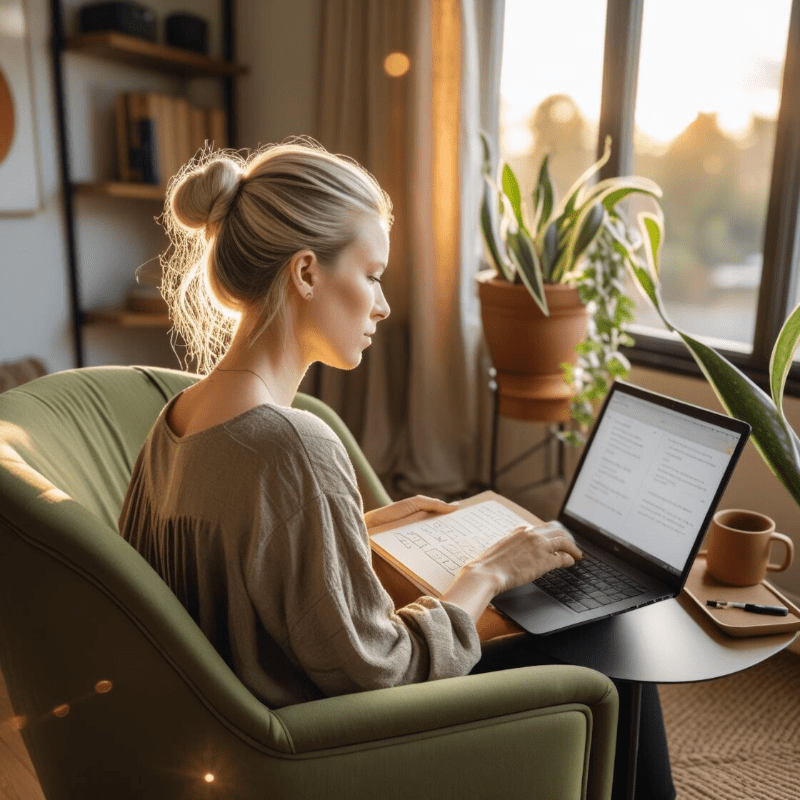
About the Author
Hi, I’m Eve, a former school counselor with a master’s degree in School Psychology and a passionate advocate for children and families navigating sensory challenges. As a mom of children with sensory sensitivities, I deeply understand the journey special-needs parents face, and I dedicate myself to researching and sharing practical solutions to help children thrive and feel comfortable in their bodies. My goal is also to empower counselors, therapists, and psychologists with creative strategies and supportive resources to enrich their everyday practice. When I’m not writing or exploring new therapeutic approaches, you’ll find me spending quality time with my family and continually seeking inspiration from everyday moments.

